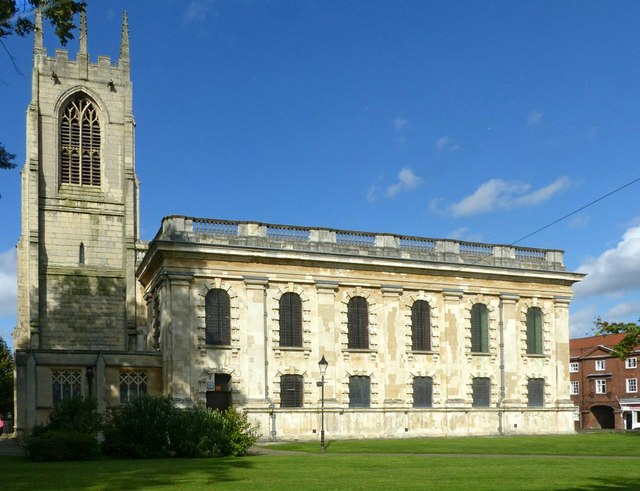SK8190 : Church of All Saints, Gainsborough
taken 7 years ago, near to Gainsborough, Lincolnshire, England

Grade I listed.
The church (except the tower) replaces an earlier mediaeval church.
The earliest mention of the church is in 1185 when it was given to the Knights Templar. It was originally dedicated to the Blessed Virgin Mary and later contained two chantry chapels with tombs of the De Burgh family surmounted by marble effigies. These appear to have been lost when the church was demolished.
The original church had a chancel, nave with aisles and a clerestory, probably from the 14th century.
It was not a handsome building, and in 1734 was in a very poor state, with numerous cracks, rotten timbers and leaning walls. The decision was made to build a new church, large enough to accommodate upwards of 3000 people. They considered the cost to be £3000, this was to be raised by a local tax, which was much opposed.
In 1736 an act of Parliament was obtained to raise the money. In 1740 a second act was procured to raise £1000 more by levying a duty on Coal.
Demolition of the old church began in 1736, and the new church was open, although not complete in 1744.
The architect was Francis Smith (1673-1738).
The tower is the only surviving part of the old church, and was originally surmounted by a spire. This was removed in the 18th century. There are eight bells, most made in the 18th C.
The church was built in the classical style. The nave has six bays and can seat 700. There are box pews and galleries to the north and south walls.
The original windows were plain glass.
To the north is a Lady Chapel containing a window designed by G. F. Bodley. Formerly this was the Thonock Chantry.
The chancel has an apse at the east end with a Venetian window and glass by Wailes. Under the mediaeval Quire Sir Edward Burgh, who first married Catherine Parr was buried in 1533. On the east wall is a copy of the last supper by Leonardo da Vinci, this was painted on dry plaster in 1874.
To the south is Saint Michael's Chapel, which was originally the Burgh Chantry with a Memorial to the Hickman family, who were Lords of the Manor.
The south wall of the nave contains a Morris window designed by Edward Burne-Jones from 1914.
Various restorations occurred over the years, the apse was redecorated in 1876, and in 1888 a new font was installed, but in 1968 the Georgian font was bought back into use and a new baptistery constructed.
The organ is a three manual by Walker from 1906.
At the west end of the church underneath the tower, two vestries were built in 1903, one of which is now a cafe and gift shop.
Listed buildings and structures are officially designated as being of special architectural, historical or cultural significance. There are over half a million listed structures in the United Kingdom, covered by around 375,000 listings.
Listed status is more commonly associated with buildings or groups of buildings, however it can cover many other structures, including bridges, headstones, steps, ponds, monuments, walls, phone boxes, wrecks, parks, and heritage sites, and in more recent times a road crossing (Abbey Road) and graffiti art (Banksy 'Spy-booth') have been included.
In England and Wales there are three main listing designations;
Grade I (2.5%) - exceptional interest, sometimes considered to be internationally important.
Grade II* (5.5%) - particularly important buildings of more than special interest.
Grade II (92%) - nationally important and of special interest.
There are also locally listed structures (at the discretion of local authorities) using A, B and C designations.
In Scotland three classifications are also used but the criteria are different. There are around 47,500 Listed buildings.
Category A (8%)- generally equivalent to Grade I and II* in England and Wales
Category B (51%)- this appears generally to cover the ground of Grade II, recognising national importance.
Category C (41%)- buildings of local importance, probably with some overlap with English Grade II.
In Northern Ireland the criteria are similar to Scotland, but the classifications are:
Grade A (2.3%)
Grade B+ (4.7%)
Grade B (93%)
Read more at Wikipedia Link
